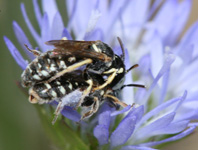Abstract
Osteological and myological characters of the ophidiid Hypopleuron caninum are described here in detail. In addition to well-known characters of Ophidiidae (e.g., anal-fin origin well posterior to dorsal-fin origin; barbel-like pelvic fin; many scales), many unique or rare conditions were also recognized, including predorsal bone and maxilla condition, and canine teeth on the premaxilla, which were suggestive of a relationship with Carapidae. Furthermore, the predorsal bone appear to be homologous with the vexillar support, a carapid synapomorphy. Although several characters differ from carapid counterparts (e.g., more anterior anal-fin origin and scales absent in Carapidae), some intermediate conditions between Ophidiidae and Carapidae are apparent in Hypopleuron caninum, which may therefore occupy an intermediate phylogenetic position between the two families. A unique morphology of small second infraorbital bone is recognized in all ophidiiform species observed in this study, and it may be a synapomorphic character of the order Ophidiiformes.
References
Anderson, M.E. & Satria, F. (2007) A new subfamily, genus, and species of pearfish (Teleostei: Ophidiiformes: Carapidae) from deep water off Indonesia. Species Diversity, 12, 73–82.
https://doi.org/10.12782/specdiv.12.73Cohen, D.M. (1974) A review of the pelagic ophidioid fish genus Brotulataenia with descriptions of two new species. Zoological Journal of the Linnean Society, 55, 119–149.
https://doi.org/10.1111/j.1096-3642.1974.tb01590.xCohen, D.M. (1982) The deepsea fish genus Enchelybrotula (Ophidiidae): description of new species, notes on distribution, and osteology. Bulletin of Marine Science, 32, 99–111.
Cohen, D.M., Inada, T., Iwamoto, T. & Scialabba, N. (1990) FAO species catalogue. Vol. 10. Gadiform fishes of the world (Order Gadiformes). In: An annotated and illustrated catalogue of cods, hakes, grenadiers and other gadiform fishes known to date. FAO Fisheries Synopsis. Vol. 10. No. 125. FAO, Rome, pp. 1–442.
de Beaufort, L.F. & Chapman, W.N. (1951) The fishes of the Indo-Australis Archipelago. Vol. IX. E. J. Brill, Leiden, 242 pp. [pp. 243–484]
Fricke, R. & Eschmeyer, W.N. (2017) Guide to fish collections. Updated 31 January 2017. Electronic version. Available from: http://researcharchive.calacademy.org/research/ichthyology/catalog/collections.asp (accessed 15 February 2017)
Endo, H. (2002) Phylogeny of the order Gadiformes (Teleostei, Paracanthopterygii). Memoirs of the Graduate School of Fisheries Sciences Hokkaido University, 49, 75–149.
Fujita, K. (1990) The caudal skeleton of teleostean fishes. Tokai University Press, Tokyo, xii + 897 pp. [in Japanese with English summary]
Gosline, W.A. (1968) The suborders of perciform fishes. Proceedings of the United States National Museum, 124, 1–78.
https://doi.org/10.5479/si.00963801.124-3647.1Ho, H.-C. & Fang, L.-Y. (2011) New record of Hypopleuron caninum Smith and Radcliffe, 1913 (Pisces: Ophidiidae) from Taiwan. Platax, 8, 1–6.
Howes, G.J. (1991) Anatomy, phylogeny and taxonomy of the gadoid fish genus Macruronus Günther, 1873. Bulletin of the British Museum of Natural History, Zoology, 51, 77–110.
Howes, G.J. (1992) Notes on the anatomy and classification of ophidiiform fishes with particular reference to the abyssal genus Acanthonus Günther, 1878. Bulletin of the British Museum of Natural History, Zoology, 58, 95–131.
Hubbs, C.L. and Lagler. K.F. (1958) Fishes of the Great Lakes region. Cranbrook Institute of Science Bulletin, 26, 1–213, 44 pls.
Imamura, H. (1996) Phylogeny of the family Platycephalidae and related taxa (Pisces: Scorpaeniformes). Species Diversity, 1, 123–233.
https://doi.org/10.12782/specdiv.1.123Imamura, H. & Yabe, M. (2002) Demise of the Scorpaeniformes (Actinopterygii: Percomorpha): an alternative phylogenetic hypothesis. Bulletin of Fisheries Sciences, Hokkaido University, 53, 107–128.
Markle, D.F. & Olney, J.E. (1990) Systematics of the pearlfishes (Pisces: Carapidae). Bulletin of Marine Science, 47, 269–410.
Møller, P.R., Knudsen, S.W., Schwarzhans, W. & Nielsen, J.G. (2016) A new classification of viviparous brotula (Bythitidae)—with family status for Dinematichthyidae - based on molecular, morphological and fossil data. Molecular Phylogenetics and Evolution, 100, 391–408.
Nielsen, J.G., Cohen, D.M., Markle, D.F. & Robins, C.R. (1999) FAO species catalogue. Volume 18. Ophidiiform fishes of the world (order Ophidiiformes). An annotated and illustrated catalogue of pearlfishes, cusk-eels, brotulas and other ophidiiforms fishes known to date. In: FAO Fisheries Synopsis. Vol. 18. No. 125. FAO, Rome, xi + 178 pp.
Parmentier, E., Bouillac, G., Dragicevic, B., Dulcic, J. & Fine, M.L. (2010) Call properties and morphology of the sound-producing organ in Ophidion rochei (Ophidiidae). Journal of Experimental Biolology, 213, 3230–3236.
https://doi.org/10.1242/jeb.044701Patterson, C. & Rosen, D.E. (1989) The Paracanthopterygii revisited: order and disorder. In: Cohen, D.M. (Ed.), Papers on the systematics of gadiform fishes. Scientific Seriese. No. 32. Natural History Museum of Los Angeles County, Los Angeles, pp. 6–36.
Prokofiev, A.M. (2004) Structure and taxonomic importance of the complex of anterior abdominal vertebrae in representatives of the order Ophidiiformes (Pisces, Paracanthopterygii) and issues of the order classification. Natural and technical sciences, 2, 129–142. [in Russian with English abstract]
Radcliffe, L. (1913) Descriptions of seven new genera and thirty-one new species of fishes of the families Brotulidae and Carapidae from the Philippine Islands and the Dutch East Indies. Proceedings of the United States National Museum, 44, 135–176.
https://doi.org/10.5479/si.00963801.44-1948.135Springer, V.G. & Johnson, G.D. (2004) Study of the dorsal gill-arch musculature of Teleostome fishes, with special reference to the Actinopterygii. Bulletin of the Biological Society of Washington, 11, 1–235, 205 pls.
Tholasilingam, T., Venkataraman, G. & Krishna Kartha, K.N. (1964) On some bathypelagic fishes taken from the continental slope of the south west coast of India. Journal of the Marine Biological Association of India, 6, 268–284.
Vilasri, V. (2013) Comparative anatomy and phylogenetic systematics of the family Uranoscopidae (Actinopterygii: Perciformes). Memoirs of the Faculty of Fisheries Sciences, Hokkaido University, 55 (1), 1–106.
Wiley, E.O. & Johnson, G.D. (2010) A teleost classification based on monophyletic groups. In: Nelson, J.S., Schultze, H.P. & Wilson, M.V.H. (Eds.), Origin and phylogenetic interrelationships of Teleosts. Verlag Dr. Friedrich Pfeil, Munich, pp. 123–182.
Winterbottom, R. (1974) A descriptive synonymy of the striated muscles of the Teleostei. Proceedings of Academy of Natural Science, Philadelphia, 125, 225–317.

